This past weekend our University Art Museum was opened up on an off day so that a grieving family could gather in the space. The woman being remembered, was a unique local artist of incredible talent. She would take found objects, broken discards, scraps of fiber, bone, clay and make assemblages that could reach deeply into your soul. Her work spoke, and I was so privileged to know her. This is an image I shot from a juried show in 2016 where I was first introduced to her.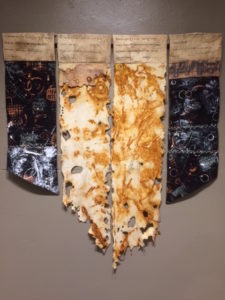
But in these last months she was not in good health, single, very private, and she sadly died alone. The family and community are heartsick. So, folks brought in things this artist had made and given away: One was a book of mixed media type quilt scraps with words of direction as if these were signs on the underground railroad. A tall wood pillar, with a house top roof, had a book within it and objects depicting Jesus’ story of the parable of the sower. Another set of notes were for women recovering from trauma in which the artist encouraged one “You know when the final piece is complete” she said, “it will result in a thing of beauty…”
I thought of how she herself is complete now, the real her, not what stayed behind. All the material bits found around her were vestiges of the unfinished, but her soul is safe, beautiful and certainly now intact. “for the spirit of man is the candle of the Lord, where He searches all the inward parts” Proverbs 20:27. I thought of words we shared, reminding each other of the promise Peter gave in the 1st century to believers: assuring that such a developing Jesus follower would not be “useless nor unfruitful”. And I expect she died just as she lived, holding onto the One she was following.
This same week I found a fascinating article about the Japanese method of repairing broken clay vessels. The ancient practice continues where cracks are filled with a lacquer-like glue, then carefully sanded and finally coated with a cover of gold. The resultant piece, with its particular history of brokenness, shines with that same jagged brokenness made beautiful. And I thought again of my friend. And I thought of the broken edges in my own life too. And I thought of what Peter says: that the proof of one’s faith in the promise of Jesus is more precious than perishable gold. And Paul said that we hold these truths in broken vessels that the surpassing greatness might be apprehended as coming from God Himself. “Therefore we do not lose heart, but though the outer man is decaying, yet our inner man is being renewed day by day.” So the clay pots pieced back together are a sign of something that broken souls long for. If it were not true, it would not resonate.
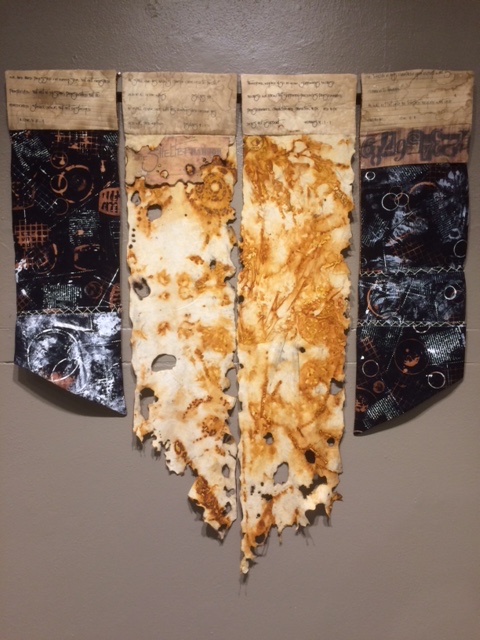
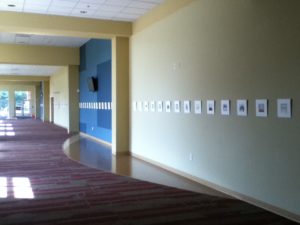
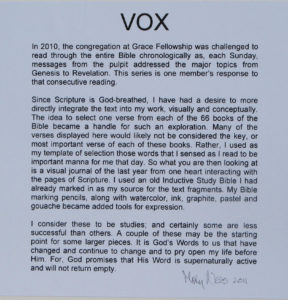
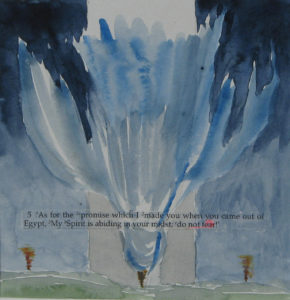
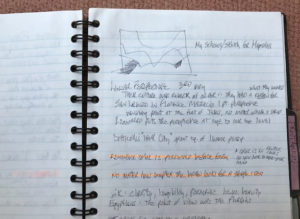 “First I have the picture” Einstein reportedly said, “then I come up with the math”. Before any of us knew how to decode language, our little eyes trained on images. Even the cones on our retinae respond to color before form is understood. We begin from image impression, but then sometimes the more we “know” what’s in front of us, the less we can wholly grasp.
“First I have the picture” Einstein reportedly said, “then I come up with the math”. Before any of us knew how to decode language, our little eyes trained on images. Even the cones on our retinae respond to color before form is understood. We begin from image impression, but then sometimes the more we “know” what’s in front of us, the less we can wholly grasp.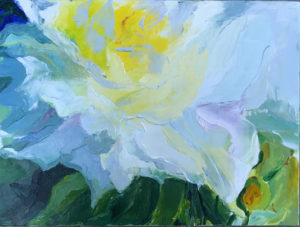 darks and lights from a photo of a magnolia blossom. What was important in translating this into paint was not “this is a magnolia’ but rather more than that, and I needed to take time to consider how. My oil color is carefully selected. But what excites me is the emergent shine, and the impasto lending toward a sense of exuberance. The cropping too was a choice, as if I am just teasing the viewer into only a glimpse. Glimpses for me are key, for if I try to tell the whole story, we’ll all get lost in words. There’s an energy in this translation into color that springs off the canvas. Usually I dive into work from an idea in my head, but to take the time to map it first, if even so simply, is important, and more than I knew. I’ve heard about the necessity of sketchbook planning, but since I’m not much of a draftsman and am also impatient, I’ve often skipped that part. “I see said the blind man”. So this mapping process was a win for me, and it’s informing further practice.
darks and lights from a photo of a magnolia blossom. What was important in translating this into paint was not “this is a magnolia’ but rather more than that, and I needed to take time to consider how. My oil color is carefully selected. But what excites me is the emergent shine, and the impasto lending toward a sense of exuberance. The cropping too was a choice, as if I am just teasing the viewer into only a glimpse. Glimpses for me are key, for if I try to tell the whole story, we’ll all get lost in words. There’s an energy in this translation into color that springs off the canvas. Usually I dive into work from an idea in my head, but to take the time to map it first, if even so simply, is important, and more than I knew. I’ve heard about the necessity of sketchbook planning, but since I’m not much of a draftsman and am also impatient, I’ve often skipped that part. “I see said the blind man”. So this mapping process was a win for me, and it’s informing further practice.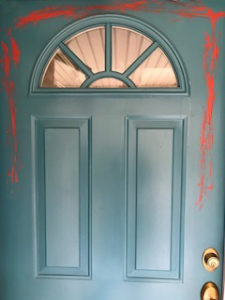 We’re preparing. And since visuals speak so powerfully to me, I painted a symbol on our front door. Similar to any other sign, one has to stop here and think. Strange things require some investigation to understand what’s really going on. People who know me already are primed for surprises. My engineer looked tentatively, bemused at the gleam in my eyes as to what I’d done now. One of my daughters just smiled at her weird mom. I got out some red paint, and researched which branches in my backyard would more closely resemble the hyssop used in Exodus. When the Israelites were told to paint blood on the lintel and posts of their doors right before their great rescue it must have been a truly weird act of faith. But the
We’re preparing. And since visuals speak so powerfully to me, I painted a symbol on our front door. Similar to any other sign, one has to stop here and think. Strange things require some investigation to understand what’s really going on. People who know me already are primed for surprises. My engineer looked tentatively, bemused at the gleam in my eyes as to what I’d done now. One of my daughters just smiled at her weird mom. I got out some red paint, and researched which branches in my backyard would more closely resemble the hyssop used in Exodus. When the Israelites were told to paint blood on the lintel and posts of their doors right before their great rescue it must have been a truly weird act of faith. But the 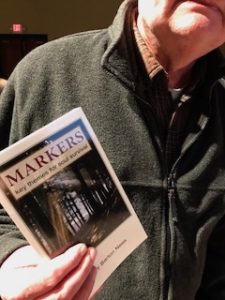
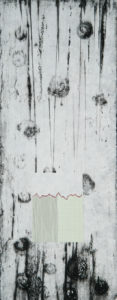 I showed them some pieces like this one, “Time and Mercy” where the chaos is falling down all around the inner life. But there on the inside is the mark of a heartbeat, and the recording of time. There’s a history that is undeniable, part of the fabric that cannot be changed. There’s a span ahead yet unknown. But in this present moment I can breathe and pause. This is the potential moment where beauty is born. For right now I can lift my head because the evidence of love is still shining through for those who are eager for it.
I showed them some pieces like this one, “Time and Mercy” where the chaos is falling down all around the inner life. But there on the inside is the mark of a heartbeat, and the recording of time. There’s a history that is undeniable, part of the fabric that cannot be changed. There’s a span ahead yet unknown. But in this present moment I can breathe and pause. This is the potential moment where beauty is born. For right now I can lift my head because the evidence of love is still shining through for those who are eager for it.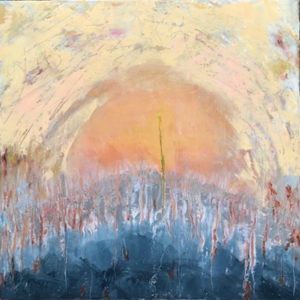 The theme keeps repeating and it’s a universal one. From mythology to classic literature this idea of trekking toward some kind of attainment is in our DNA. Moses, Odysseus, Buddha, Lao Tzu, Dante — the list is long of courageous ones who were answering the ancient quest “where have you come from, and where are you going?”* Something keeps us moving, sometimes for what we’re not even sure; and if our bodies get tired, our spirits keep longing.
The theme keeps repeating and it’s a universal one. From mythology to classic literature this idea of trekking toward some kind of attainment is in our DNA. Moses, Odysseus, Buddha, Lao Tzu, Dante — the list is long of courageous ones who were answering the ancient quest “where have you come from, and where are you going?”* Something keeps us moving, sometimes for what we’re not even sure; and if our bodies get tired, our spirits keep longing.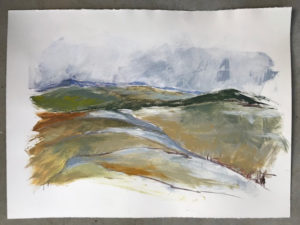 cam. It’s lived so slow from our angle. We move here on the ground at a snail’s response to what is happening second by second in the heavenlies. My sky here is active, for that’s where the real drama is being directed. The land only reflects the weather patterns and the light working above it. I live on the ground, held by gravity, where time creeps sometimes agonizingly slow. I don’t like that slowness, for there’s so much that needs to change down here, so much I long for from the only One who can bring us justice and peace. Humans and their leaders so disappoint me! He said He’d return, why is He taking so long!?
cam. It’s lived so slow from our angle. We move here on the ground at a snail’s response to what is happening second by second in the heavenlies. My sky here is active, for that’s where the real drama is being directed. The land only reflects the weather patterns and the light working above it. I live on the ground, held by gravity, where time creeps sometimes agonizingly slow. I don’t like that slowness, for there’s so much that needs to change down here, so much I long for from the only One who can bring us justice and peace. Humans and their leaders so disappoint me! He said He’d return, why is He taking so long!?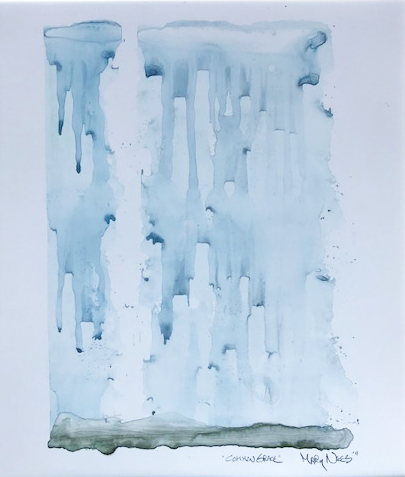
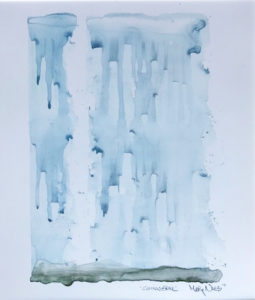 The advantage I have doing art is that I can “tell it slant” as Emily Dickinson used to say. There is no muzzle on when the work sings with beauty on its own. Makoto Fujimura explains it: “Art is an inherently hopeful act, an act that echoes the creativity of the Creator. Every time an architect imagines a new building, an artist envisions that first stroke of a brush on a white canvas, a poet seeks a resonant sound in words, or a choreographer weaves a pause in layers of movements, that act is done in hope; the creator reaches out in hope to call the world into that creation.” –Refractions (NavPress, 2009), 68.
The advantage I have doing art is that I can “tell it slant” as Emily Dickinson used to say. There is no muzzle on when the work sings with beauty on its own. Makoto Fujimura explains it: “Art is an inherently hopeful act, an act that echoes the creativity of the Creator. Every time an architect imagines a new building, an artist envisions that first stroke of a brush on a white canvas, a poet seeks a resonant sound in words, or a choreographer weaves a pause in layers of movements, that act is done in hope; the creator reaches out in hope to call the world into that creation.” –Refractions (NavPress, 2009), 68.
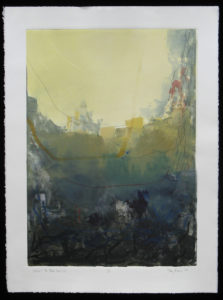 A good portion of my work is an intuitive response, rapidly laid down. This does not mean that the result seen on paper was altogether quick, though if you had watched this piece and others being birthed you might think so. What is visible is an end product of a long term simmering from my mind, spirit and body. The thoughts that collide toward and then into a particular working session, the prayers that have been raised and linger as I craft, and the arms and legs that labor this forward are mine.
A good portion of my work is an intuitive response, rapidly laid down. This does not mean that the result seen on paper was altogether quick, though if you had watched this piece and others being birthed you might think so. What is visible is an end product of a long term simmering from my mind, spirit and body. The thoughts that collide toward and then into a particular working session, the prayers that have been raised and linger as I craft, and the arms and legs that labor this forward are mine. Most all of us, living housed in our bodies, have functioning eyes. I love my eyes, and thank God for them; for with them I notice expression that tells me so much more than words. With them I can work with my hands at all kinds of things. With them I can apprehend beauty. And then with them I can lower my lids and signal the whole of my body to rest.
Most all of us, living housed in our bodies, have functioning eyes. I love my eyes, and thank God for them; for with them I notice expression that tells me so much more than words. With them I can work with my hands at all kinds of things. With them I can apprehend beauty. And then with them I can lower my lids and signal the whole of my body to rest.